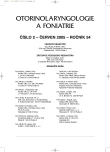Reflex Response of the Stapes Muscle Induced by Acoustic Stimulation: Systematic Arrangement of Conditions for the Induction
Authors:
M. Lejska
Authors‘ workplace:
AUDIO – Fon centr. s. r. o., Brno
přednosta doc. MUDr. M. Lejska, CSc.
Published in:
Otorinolaryngol Foniatr, 54, 2005, No. 2, pp. 91-95.
Category:
Original Article
Overview
Summary:
The examination employing the methods of impendance audiometry became a basic constituent of every audiological examination. The examination of musculus stapedius proved to be more important than them examination of middle ear pressure (tympanometric curve). It can be used for various diagnostic deductions: cochlear symptoms x retrocochlear symptoms, sensorineural x conductible, partial hearing loss x deafness and other others.
The induction of stapes reflex depends on a series of necessary conditions. They include:
1. Conditions of internal environment of the organism concerning integrity of the reflex arch and temporary acoustic summation. 2. Conditions of external acoustic stimulation encompassing laterality of stimulation, energy content of the stimulus. 3. The conditions of changes in physical parameters of external stimulation in the environment of the auditory apparatus (mixed conditions) – external auditory duct, middle ear.
Based of numerous literature data, the author’s own clinical and experimental studies, the paper presents a systemic outline of all conditions required for induction of the stapes reflex.
Key words:
stapes reflex, conditions of origin, systematic classification.
Labels
Audiology Paediatric ENT ENT (Otorhinolaryngology)Article was published in
Otorhinolaryngology and Phoniatrics

2005 Issue 2
Most read in this issue
- Surgical Treatment of Lower Concha Hypertrophy by Means of Microdebrider
- Reflex Response of the Stapes Muscle Induced by Acoustic Stimulation: Systematic Arrangement of Conditions for the Induction
- Short-term and Long-term Functional Results of Stapedoplasty
- Experience in Vestibular Habituation Training in the Therapy of Balance Disorders
